Rotten Wood - Find it Before it Destroys Your House
Is Rotten Wood Hiding in Your Home?
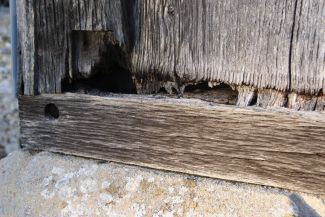
Given enough time and the right conditions, rot can completely destroy wooden building materials.
Occasionally, our houses scream for attention when they need repairs. For instance, it is pretty obvious that you need to spring into action if a water leak begins to gush through your ceiling or if a baseball crashes through your living room window.
However, unlike major water leaks or broken windows, rotting wood can easily escape notice, unless you specifically look for it. And unfortunately, like kudzu or a spot of rust on a car, wood rot can spread far and wide, making it especially dangerous to your home’s wooden building materials.
Because of its tendency to spread, you should repair rotten wood ASAP when you discover it, and make sure you fix it completely. Otherwise, you will only face more serious and extensive repairs down the road. Ultimately, serious enough wood rot can even compromise your home’s structural integrity (look around your home – you see a lot of wood, right?). So, what should homeowners know about rotten wood?
Causes of Rotten Wood
Understanding wood rot is the first step towards fighting it, so take a minute to think about what causes wood to rot. It is actually fairly simple – lingering moisture in wood creates an environment conducive to fungi growth, which in turn causes the wood’s fibers to deteriorate. So, when water contacts an unprotected wood surface for a long enough period of time, the wood begins to rot.
 Lingering moisture on unprotected wood allows fungi to grow, eventually causing rot.
Lingering moisture on unprotected wood allows fungi to grow, eventually causing rot.
Regardless of whether this process begins by rain collecting gently on your window sill or a major leak pouring through your ceiling, wood rot can be astonishingly destructive. Think about the places in your home where moisture could collect – on window sills, near outside doors, or under sinks, for example. These areas are susceptible to wood rot, so keep your eye on them.
Finding Rotten Wood
So, how do you actually go about finding wood rot? You’ll need both your senses of sight and touch for this task, as well as a screwdriver, flashlight, and binoculars. Keep in mind that, although sometimes the rot you are looking for may be easily visible, in plain sight, quite often it will be hidden, for instance behind cracked paint or underneath siding.
One key (and hopefully obvious) principle to bear in mind during your search: wood should not be soft when you press on it.
 Use a screwdriver to probe for rot in your home’s wooden components.
Use a screwdriver to probe for rot in your home’s wooden components.
I know – that is probably obvious to most of us. However, to evaluate the health of the wooden components of your home, you do need to give them a good poke and see how they feel. Be on the lookout for any sign of soft, brittle, or crumbly wood. In extreme cases rotten wood may even disintegrate as you touch it.
As you poke around, keep your eyes peeled for discoloration, which is a sign of fungi and rot. Also, if you find a surface with peeling paint that feels damp, you may have just uncovered a water leak behind that spot. Investigate further and fix any leaks you find.
On the subject of damaged paint, check any painted or sealed wooden surfaces on your home’s exterior for cracks in the paint or sealant. Any crack you find, even small ones, can allow water to work its way into the wooden material, resulting in rot.
What if your house’s surface is vinyl or aluminum? Could it still succumb to rotten wood? The answer is yes, since even vinyl or aluminum sided homes likely still have wooden framing, plywood, and trim. Take a look at these wooden components, to the extent possible, and get a sense of their health. Look for damage to the siding, which might let water through, and arm yourself with binoculars and a flashlight to spot wear or discoloration in places you cannot see close up. In areas where you can get close to a wood surface, press it with a screw driver to test its integrity.
You should inspect your home for rotting wood at least annually - or twice per year if you live in a damp climate. Ideally, make this inspection a regular part of your spring and fall maintenance routine.
Specific Areas to Check for Rotting Wood
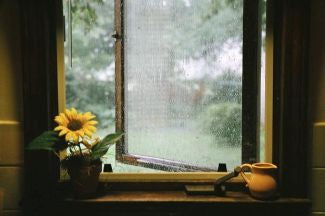 Over time, rain can repeatedly soak window frames and sills, causing damage and, eventually, rot.
Over time, rain can repeatedly soak window frames and sills, causing damage and, eventually, rot.
Here are some particularly vulnerable areas that you should keep a close eye on:
Wooden Window Frames: Water tends to remain on window sills longer than on the rest of the window frame, so the sills are usually the first to suffer from rot. Rain is persistent and can have a powerful cumulative effect. Over time, as rainwater collects on a window sill, it can slowly wear away the paint, allowing water to seep into the wood, and eventually leading to rot. As you inspect your window sills, carefully press the wood to detect any soft, deteriorated areas. Use a screw driver in hard-to-reach places. If the wood punctures easily, replace it ASAP. Finally, inspect the rest of the window frame, as wood rot often spreads up from the sill to the vertical framing pieces and trim.
 Exterior doors can get damaged over time through normal wear and tear. Add moisture to the mix and rot could eventually result.
Exterior doors can get damaged over time through normal wear and tear. Add moisture to the mix and rot could eventually result.
Exterior Doors: There is a good chance that your exterior doorways contain a lot of wood, which gets damaged over time from normal wear and tear, making it vulnerable to rainwater. Check all wooden parts of the door and door frame, including the threshold, door jamb, and trim. Make sure there are no soft, spongy areas. The lower sections of the door tend to be prime areas for fungi to form – especially if your home does not have a roof overhang to help protect the entrance from the weather. Poke around with your screw driver to make sure the wood is sound. Inspect the kick plate at the bottom of the door – is there any sign of rot underneath it?
Interior Spaces: Grab your flashlight and pay a down-and-dirty visit to the places in your home where moisture might have a chance to collect. Check the floor areas around your water heater, washer, dishwasher, toilet, tub, and the bottom of your sink cabinets. Unfortunately, this involves some grunt work. Prepare to get down on your hands and knees to peer underneath appliances and clean out those cluttered sink cabinets.
Do a thorough visual inspection with your flashlight, and also run your hand over the wooden surfaces as you look at them. If you come across areas that seem to be consistently moist or find swelling in the floor or sub-floor, you have probably discovered a leak. Investigate further ASAP. Also, check ceilings for any telltale water damage discoloration created by leaks from above.
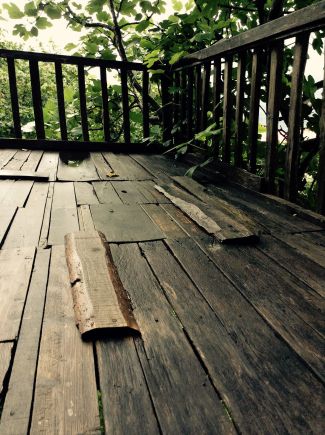 Most decks contain a lot of wood and will require a thorough inspection for rot. Check it from above, from below, and assess the health of the ledger board.
Most decks contain a lot of wood and will require a thorough inspection for rot. Check it from above, from below, and assess the health of the ledger board.
Decks: First, inspect the wooden components that make up your deck and deck stairs for signs of rot – looking from both above (easy!) and below (potentially dirty work!). After that, direct your attention to the piece of wood that attaches your deck to the house. This is called a ledger board, and it is a prime spot for wood rot if it was not connected properly. It should be flashed in aluminum, and when that is not the case, water can get behind it, eventually causing rot. This is a crucial item to check, since rot here can spread to the house’s structure underneath your siding.
Roof: Go out to your yard with binoculars and train them on your roof. Make a close inspection of both the roof itself, as well as the area directly below the roof line, for any wear and tear. This inspection could take a little while. It might feel a bit strange to be standing in the yard or out by the road scanning your roof with binoculars, and you might get a few looks from the neighbors, but take the time to be thorough. Catching a problem early could save you lots of money and hassle.
 On your roof, look for damaged or missing shingles, raised nail heads, cracked seals around chimneys and vent pipes, and discoloration on the fascia below the roof line.
On your roof, look for damaged or missing shingles, raised nail heads, cracked seals around chimneys and vent pipes, and discoloration on the fascia below the roof line.
Look for any missing or curled shingles, raised nail heads, cracked seals around chimneys and vent pipes, and also for discoloration on the fascia below your roof line. You may choose to get up on your roof if the pitch is not too steep, which will allow you to feel for any sponginess in the plywood as you walk across it. If you think the roof may be weak, or do not want to take the risk of going up on your roof, have a professional examine it instead. Roofs and ladders can be very tricky to navigate, so if you do go up there, exercise the utmost caution.
Preventing Wood Rot
Now that you know where to look to find rotting wood in your home, here are some tips to prevent it in the first place.
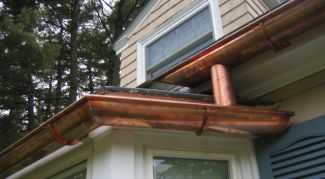 Clean and maintain your gutter system regularly so that water is drawn away from your house.
Clean and maintain your gutter system regularly so that water is drawn away from your house.
Maintain your gutters: Well functioning gutters make for a healthy house. Clean your gutters regularly, and keep them in good condition so that rainwater will be drawn away from your house. Water should flow down your spouts, and away from the structure, instead of overflowing out of the gutters and spilling right next to your foundation.
Building materials: Instead of using wood in areas of your house where rot is common, consider using composite building materials with no wood fibers. For example, when replacing windows use vinyl or vinyl clad designs. Similarly, consider aluminum or vinyl siding, which are popular for this reason. Preventative measures like this will help reduce your maintenance costs over time.
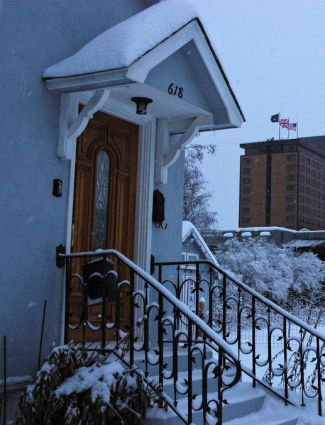 Add covered entryways and overhangs to your roof, to protect your windows and doors from precipitation.
Add covered entryways and overhangs to your roof, to protect your windows and doors from precipitation.
Entryways: Next time you re-do your roof, add overhangs and covered entryways if you do not have them already. This added shelter helps to protect your windows and doors from moisture.
Condensation: Keep condensation at bay inside your home. Although it sounds counter-intuitive, an air-tight, well-insulated house can tend to trap moisture indoors. To prevent this, ensure that your bathrooms, kitchens, and laundry rooms are well-ventilated. Proper ventilation is amazingly effective at dissipating humidity through natural airflow (hot, moist air rises and is replaced by fresh air). If necessary, use a dehumidifier to keep persistent moisture problems under control.
Maintain your caulk and paint: Keep any caulking on your home’s exterior in good condition – this is fairly self explanatory, since caulk seals moisture out of your house. Paint is also a vital seal against the elements. In fact, it is often the sole barrier keeping solid wood from rotting, so it is imperative to keep your home wrapped in a good coat of paint.
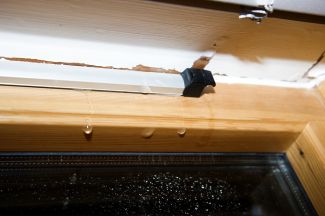 Keep your eye out for water leaks in your home. When you find them, fix them immediately, so they don’t turn into larger problems.
Keep your eye out for water leaks in your home. When you find them, fix them immediately, so they don’t turn into larger problems.
Water leaks and basement flooding: Stay alert for water leaks in your home and repair them quickly, regardless of how small they seem. Even a small amount of water can ruin wood, and small leaks often develop into larger problems. Take preventative action, where possible, to prevent or minimize water damage in your home. Use an automatic water shut off valve to turn off your water when a leak occurs. To protect your basement, consider installing a battery backup sump pump or water powered sump pump to take over for your primary sump pump if your power goes out during a storm, or if the primary pump fails.
To keep your home in good shape, you will need to play the role of detective from time to time, watching for potential problems and investigating those that arise. This is certainly true if you want to avoid rotten wood. Even though rot may not be discernible at first glance, by searching for the right clues, you can spot problems before they become unmanageable.
When you do find rotting wood on your property, get if fixed right away so it does not turn into a larger problem. Finally, take all the preventative measures you can to prevent rot in the first place.
Image Sources: fourthandfifteen/chelmsfordblue, wetsun, Timothy Vollmer/sixteenmilesofstring, Nico Paix/aerosolhalos, takomabibelot (cropped), Nilgün Gül Özer, Brian Robinson/dolfindans, Ctd 2005/kikisdad, wonderlane (cropped), Bob Peters.
 The Rotten Wood - Find it Before it Destroys Your House by Water Damage Defense, is licensed under a Creative Commons Attribution-ShareAlike 3.0 Unported License.
The Rotten Wood - Find it Before it Destroys Your House by Water Damage Defense, is licensed under a Creative Commons Attribution-ShareAlike 3.0 Unported License.
